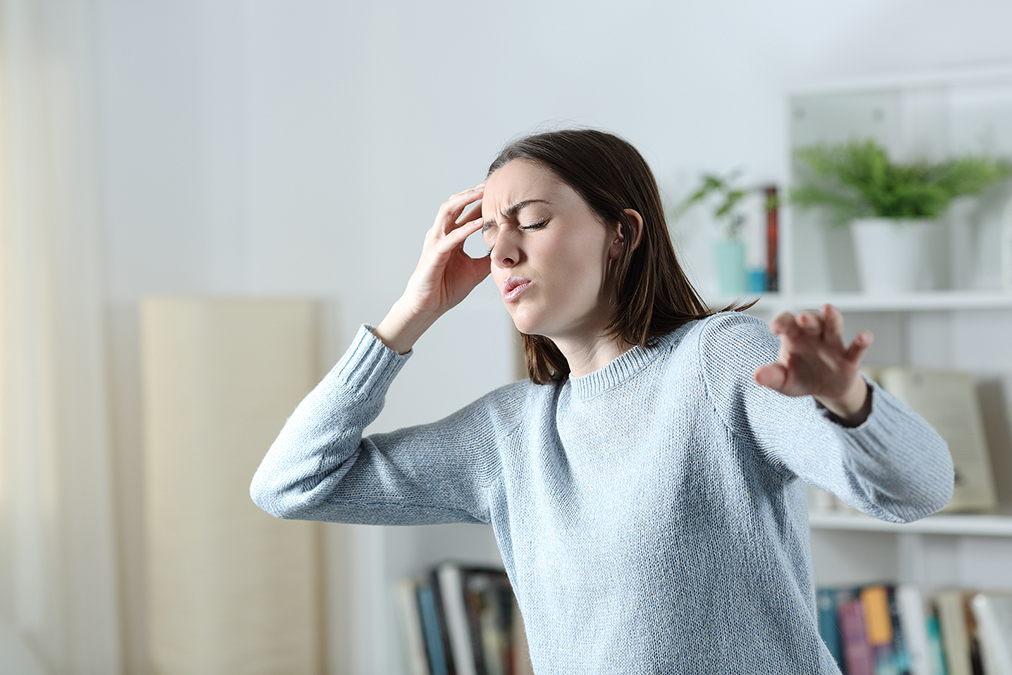 Vertigo is one of the most common health complaints that doctors get. Most of the time, they’re unable to help.
Vertigo is one of the most common health complaints that doctors get. Most of the time, they’re unable to help.
And even after doctors use their most effective techniques to treat vertigo, and after it seems like the underlying cause is gone, the vertigo continues.
But a study in the latest Chinese Journal of Otorhinolaryngology–Head and Neck Surgery now reveals a simple method to eliminate this residual vertigo after initial treatment.
Benign paroxysmal positional vertigo is the type of vertigo in which calcium crystals fall into the semicircular canals in your inner ear, where they irritate the nerve hairs that send balance information to your brain.
Drugs cannot cure this type of vertigo. The most common treatment method is head movements that move the calcium crystals back out of the canals so they can no longer interfere with the information those nerve hairs send to your brain.
But even after completing a program of head movements, many vertigo sufferers still struggle with residual dizziness and the accompanying difficulty in daily function.
With these people in mind, scientists from Fudan University in Shanghai conducted a study to see how to finish off that residual vertigo that survives initial treatment.
They recruited 129 people with benign paroxysmal positional vertigo who had undergone successful canalith repositioning procedures and whose circular canals were now free of these irritating calcium invaders.
All the subjects were still struggling with residual dizziness.
The researchers divided them into three groups:
- • one that received no additional treatment.
• one that received vestibular rehabilitation training for four weeks.
• one that received 12 milligrams of betahistine three times a day for four weeks. Betahistine is an antihistamine commonly prescribed for vertigo.
At the end of the four weeks, the participants completed the commonly used Vestibular Activities and Participation measure, a questionnaire that asks respondents about their daily activities and social participation to check the effects of dizziness on their lives.
In addition, the researchers performed a sensory organization test, a common balance test that assesses subjects’ ability to use visual and other sensory clues to maintain their postural stability.
These were the final results of the study:
- 1. The daily activities and social participation of all three groups improved over time, with the subjects in the vestibular rehabilitation group experiencing the fastest improvement. There was no difference between the rates at which the other two groups improved.
2. The balance of all three groups improved at the same rate until reaching normal levels.
3. It took between two and three weeks for all symptoms to resolve.

 Multiple Sclerosis
Multiple Sclerosis Banishing Bronchitis
Banishing Bronchitis Gum Disease Gone
Gum Disease Gone Overcoming Onychomycosis
Overcoming Onychomycosis Neuropathy No More
Neuropathy No More The Prostate Protocol
The Prostate Protocol Brain Booster
Brain Booster
 Ironbound
Ironbound
 Solution for Shingles
Solution for Shingles
 The Bone Density Solution
The Bone Density Solution
 The Ultimate Healing Protocol
The Ultimate Healing Protocol
 The Parkinson's Protocol
The Parkinson's Protocol
 The Chronic Kidney Disease Solution
The Chronic Kidney Disease Solution
 Overthrowing Anxiety
Overthrowing Anxiety The Fatty Liver Solution
The Fatty Liver Solution The Hypothyroidism Solution
The Hypothyroidism Solution
 The End of Gout
The End of Gout The Blood Pressure Program
The Blood Pressure Program
 The Oxigized Cholesterol Strategy
The Oxigized Cholesterol Strategy
 Stop Snoring And Sleep Apnea Program
Stop Snoring And Sleep Apnea Program
 The Arthritis Strategy
The Arthritis Strategy The Vertigo & Dizziness Program
The Vertigo & Dizziness Program The 3-Step Diabetes Strategy
The 3-Step Diabetes Strategy Hemorrhoids Healing Protocol
Hemorrhoids Healing Protocol The Erectile Dysfunction Master
The Erectile Dysfunction Master Weight Loss Breeze
Weight Loss Breeze The IBS Program
The IBS Program The Insomnia Program
The Insomnia Program The Migraine and Headache Program
The Migraine and Headache Program The Neck Pain Solution
The Neck Pain Solution The Menopause Solution
The Menopause Solution The Ejaculation Master
The Ejaculation Master The TMJ Solution
The TMJ Solution The Acid Reflux Solution
The Acid Reflux Solution The Fibromyalgia Solution
The Fibromyalgia Solution The Psoriasis Strategy
The Psoriasis Strategy